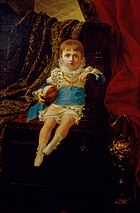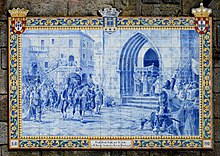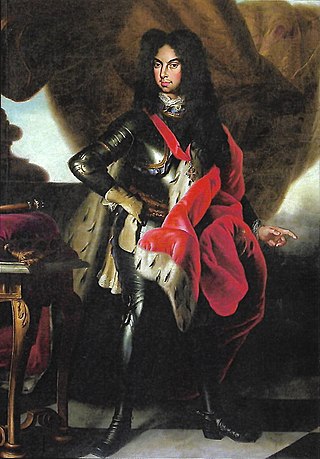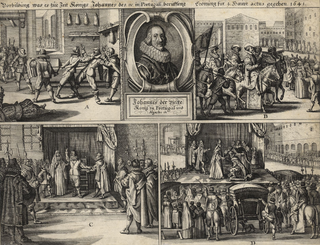John IV of Portugal
Last updated| John IV | |
|---|---|
 Portrait by Peter Paul Rubens, c. 1628 | |
| King of Portugal | |
| Reign | 1 December 1640 – 6 November 1656 |
| Coronation | 15 December 1640 |
| Predecessor | Philip III |
| Successor | Afonso VI |
| Born | 18 March 1604 Ducal Palace of Vila Viçosa, Vila Viçosa, Portugal |
| Died | 6 November 1656 (aged 52) Ribeira Palace, Lisbon, Portugal |
| Burial | |
| Spouse | Luisa de Guzmán (m. 1633) |
| Issue Detail | Teodósio, Prince of Brazil Joana, Princess of Beira Catherine, Queen of England, Scotland, and Ireland Afonso VI, King of Portugal Peter II, King of Portugal |
| House | Braganza [1] |
| Father | Teodósio II, Duke of Braganza |
| Mother | Ana de Velasco y Girón |
| Religion | Roman Catholicism |
| Signature |  |
John IV (Portuguese : João, [2] pronounced [ʒuˈɐ̃w] ; 18 March 1604 – 6 November 1656), nicknamed John the Restorer (Portuguese : João, o Restaurador), was the King of Portugal whose reign, lasting from 1640 until his death, began the Portuguese restoration of independence from Habsburg Spanish rule. [1] His accession established the House of Braganza on the Portuguese throne, and marked the end of the 60-year-old Iberian Union by which Portugal and Spain shared the same monarch.
Contents
- Early life
- Reign
- Accession
- Restoration War
- Imperial Recovery
- Death and legacy
- Marriages and descendants
- Ancestry
- References
- Bibliography
- External links
Before becoming king, he was John II, the 8th Duke of Braganza. He was the grandson of Catherine, Duchess of Braganza, [3] a claimant to the crown during the Portuguese succession crisis of 1580. On the eve of his death in 1656, the Portuguese Empire was at its territorial zenith, spanning the globe. [4]
Early life

John IV was born at Vila Viçosa and succeeded his father Teodósio II as Duke of Braganza [5] when the latter died insane in 1630. He married Luisa de Guzmán (1613–66), the eldest daughter of Juan Manuel Pérez de Guzmán, 8th Duke of Medina Sidonia, in 1633. John was described as having blonde hair and an average height. [6]
Reign
Accession


When Philip II of Portugal (III of Spain) died, he was succeeded by his son Philip III (IV of Spain), who had a different approach to Portuguese issues. Taxes on the Portuguese merchants were raised, the Portuguese nobility began to lose its influence, and government posts in Portugal were increasingly occupied by Spaniards. Ultimately, Philip III tried to make Portugal a Spanish province, meaning Portuguese nobles stood to lose all of their power.
This situation culminated in a revolution organized by the nobility and the bourgeoisie , [1] executed on 1 December 1640, sixty years after the accession of Philip II of Spain to the throne of Portugal. A plot was planned by several associates, known as the Forty Conspirators, who killed the Secretary of State, Miguel de Vasconcelos, and imprisoned the king's cousin, Margaret of Savoy, the Vicereine of Portugal, governing the country in the King's name. Philip's troops were at the time fighting the Thirty Years' War and also dealing with a revolution in Catalonia, which severely hampered Spain's ability to quash the rebellion.
Within a matter of hours and with popular support, John, then the 8th Duke of Braganza, was acclaimed as King John IV of Portugal [1] (as legend goes, with the persuasion of his wife), claiming legitimate succession through his grandmother Catherine, Duchess of Braganza. [7] The ensuing conflict with Spain brought Portugal into the Thirty Years' War as, at least, a peripheral player. From 1641 to 1668, the period during which the two nations were at war, Spain sought to isolate Portugal militarily and diplomatically, and Portugal tried to find the resources to maintain its independence through political alliances and maintenance of its colonial income.
Restoration War
His accession led to a protracted war with neighbouring Spain, a conflict known as the Portuguese Restoration War, which ended with the recognition of Portuguese independence in a subsequent reign (1668). [8] Portugal signed lengthy alliances with France (1 June 1641) and Sweden (August 1641) but by necessity its only contributions in the Thirty Years' War were in the field against Spain and against Dutch encroachments on the Portuguese colonies.
The period from 1640 to 1668 was marked by periodic skirmishes between Portugal and Spain, as well as short episodes of more serious warfare, much of it occasioned by Spanish and Portuguese entanglements with non-Iberian powers. Spain was involved in the Thirty Years' War until 1648 and the Franco-Spanish War until 1659, while Portugal was involved in the Dutch–Portuguese War until 1663. In Spain, a Portuguese invasion force defeated the Spanish at Montijo, near Badajoz, in 1644.
Imperial Recovery
Abroad, the Dutch took Portuguese Malacca (January 1641), and the Imam of Oman captured Muscat (1650). Nevertheless, the Portuguese, despite having to divide their forces among Europe, Brazil, and Africa, managed to retake Luanda, in Portuguese Angola, from the Dutch in 1648 and, by 1654, had recovered northern Brazil, which effectively ceased to be a Dutch colony. This was countered by the loss of Portuguese Ceylon (present day Sri Lanka) to the Dutch, who took Colombo in 1656.
Death and legacy
King John IV died in 1656 and was succeeded by his son Afonso VI. His daughter, Catherine of Braganza, married King Charles II of England. [3] Bombay in India was given as dowry to the English.
John was a patron of music and the arts, and a considerably sophisticated writer on music; in addition to this, he was a composer. During his reign he collected one of the largest libraries in the world, but it was destroyed in the Lisbon earthquake of 1755. Among his writings are a defense of Palestrina, and a Defense of Modern Music (Lisbon, 1649). [9] One famous composition attributed to him is a setting of the Crux fidelis , a work that remains highly popular during Holy Week amongst church choirs. However, no known manuscript of the work exists, and it was first published only in 1869, in France. On stylistic grounds, it is generally recognized that the work was written in the 19th century. [10]
In 1646, John IV proclaimed Mary, in her conception as the Immaculate Conception (the 'Immaculata'), the Patroness of Portugal by royal decree of the House of Braganza. The doctrine had appeared in the Middle Ages and had been fiercely debated in the 15th and 16th centuries, but a bull issued in 1616 by Pope Paul V finally "[forbade] anyone to teach or preach a contrary opinion." [11] Three years later, in 1649, the iconography of the Immaculata was established by Francisco Pacheco (1564–1654), a Spanish artistic advisor to the Inquisition, based on Revelation XII:1. [12]
Marriages and descendants
John married Luisa de Guzmán, [13] daughter of Juan Manuel Pérez de Guzmán, 8th Duke of Medina-Sidonia. From that marriage several children were born. Because some of John's children were born and died before their father became king they are not considered infantes or infantas (heirs to the throne) of Portugal.
| Name | Birth | Death | Notes |
|---|---|---|---|
| By Luisa de Guzmán (13 October 1613 – 27 February 1666; married on 12 January 1633) | |||
| Infante Teodósio | 8 February 1634 | 13 May 1653 | Prince of Brazil and 9th Duke of Braganza. Died young. |
| Ana de Bragança | 21 January 1635 | 21 January 1635 | |
| Infanta Joana (Joan) | 18 September 1635 | 17 November 1653 | |
| Infanta Catherine (Catarina) | 25 November 1638 | 31 December 1705 | Commonly known as Catherine of Braganza. Queen consort through marriage to Charles II of England. |
| Manuel de Bragança | 6 September 1640 | 6 September 1640 | |
| Infante Afonso | 21 August 1643 | 12 September 1683 | Prince of Brazil and 10th Duke of Braganza. Succeeded him as Afonso VI, King of Portugal. |
| Infante Peter (Pedro) | 26 April 1648 | 9 December 1706 | Duke of Beja, Constable of the Kingdom, Lord of the Casa do Infantado and Regent of the Kingdom before succeeding his brother Afonso as Peter II, King of Portugal. |
| Illegitimate offspring | |||
| Maria de Bragança | 30 April 1644 | 7 February 1693 | Natural daughter. |
Ancestry
| Ancestors of John IV of Portugal | |||||||||||||||||||||||||||||||||||||||||||||||||||||||||||||||||||||||||||||||||||||||||||||||||||||||||||||||||||||||||||||||||||||||||||||||||||||||||||||||||||||||||||||||||||||||||||||||||||||||||||||||||||||||||||||||||||||||||||||||||||||||||||||||||||||||||||||||||||||||||
|---|---|---|---|---|---|---|---|---|---|---|---|---|---|---|---|---|---|---|---|---|---|---|---|---|---|---|---|---|---|---|---|---|---|---|---|---|---|---|---|---|---|---|---|---|---|---|---|---|---|---|---|---|---|---|---|---|---|---|---|---|---|---|---|---|---|---|---|---|---|---|---|---|---|---|---|---|---|---|---|---|---|---|---|---|---|---|---|---|---|---|---|---|---|---|---|---|---|---|---|---|---|---|---|---|---|---|---|---|---|---|---|---|---|---|---|---|---|---|---|---|---|---|---|---|---|---|---|---|---|---|---|---|---|---|---|---|---|---|---|---|---|---|---|---|---|---|---|---|---|---|---|---|---|---|---|---|---|---|---|---|---|---|---|---|---|---|---|---|---|---|---|---|---|---|---|---|---|---|---|---|---|---|---|---|---|---|---|---|---|---|---|---|---|---|---|---|---|---|---|---|---|---|---|---|---|---|---|---|---|---|---|---|---|---|---|---|---|---|---|---|---|---|---|---|---|---|---|---|---|---|---|---|---|---|---|---|---|---|---|---|---|---|---|---|---|---|---|---|---|---|---|---|---|---|---|---|---|---|---|---|---|---|---|---|---|---|---|---|---|---|---|---|---|---|---|---|---|---|---|---|---|
| |||||||||||||||||||||||||||||||||||||||||||||||||||||||||||||||||||||||||||||||||||||||||||||||||||||||||||||||||||||||||||||||||||||||||||||||||||||||||||||||||||||||||||||||||||||||||||||||||||||||||||||||||||||||||||||||||||||||||||||||||||||||||||||||||||||||||||||||||||||||||
Related Research Articles

Afonso VI, known as "the Victorious", was the second king of Portugal of the House of Braganza from 1656 until his death. He was initially under the regency of his mother, Luisa de Guzmán, until 1662, when he removed her to a convent and took power with the help of his favourite, the Luís de Vasconcelos e Sousa, 3rd Count of Castelo Melhor.

DomPedro II, nicknamed "the Pacific", was King of Portugal from 1683 until his death, previously serving as regent for his brother Afonso VI from 1668 until his own accession. He was the fifth and last child of John IV and Luisa de Guzmán.

Teodósio II, 7th Duke of Braganza was a Portuguese nobleman and father of João IV of Portugal. He is known for his allegiance to King Philip I of Portugal.

The Most Serene House of Braganza, also known as the Brigantine dynasty, is a dynasty of emperors, kings, princes, and dukes of Portuguese origin which reigned in Europe and the Americas.

The Iberian Union was the dynastic union of Spain, which in turn was itself a dynastic union of the crowns of Castile and Aragon, and Portugal, and of their respective colonial empires, that existed between 1580 and 1640 and brought the entire Iberian Peninsula except Andorra, as well as Portuguese and Spanish overseas possessions, under the Spanish Habsburg monarchs Philip II, Philip III, and Philip IV. The union began after the Portuguese crisis of succession and the ensuing War of the Portuguese Succession, and lasted until the Portuguese Restoration War, during which the House of Braganza was established as Portugal's new ruling dynasty with the acclamation of John IV as the new King of Portugal.

The Portuguese succession crisis of 1580 emerged as a result of the deaths of young King Sebastian I of Portugal in the Battle of Alcácer Quibir in 1578 and his successor and great-uncle Henry I in 1580. As Sebastian and Henry lacked immediate heirs, a dynastic crisis unfolded, marked by internal conflicts and external contenders vying for the Portuguese throne. Ultimately, Philip II of Spain succeeded Henry I as King of Portugal, uniting the Portuguese and Spanish Crowns in the Iberian Union. This personal union endured for 60 years, during which the Portuguese Empire faced decline and global challenges, notably the Dutch–Portuguese War.

The Philippine dynasty, also known as the House of Habsburg in Portugal, was the third royal house of Portugal. It was named after the three Habsburg Spanish kings, all named Philip, who ruled Portugal between 1581 and 1640 under the Iberian Union, a dynastic union of the crowns of Spain and Portugal. The dynasty's kings were Philip I, Philip II and Philip III.

Don Teodósio, Prince of Brazil, Duke of Braganza was the heir apparent son of John IV of Portugal and his wife Luisa de Guzmán. In 1645, he was given the title of Prince of Brazil, a new crown princely position thus created. Also, his father granted him the duchy as 10th Duke of Braganza, presumably after his uncle Duarte died in 1649.

From the House of Braganza restoration in 1640 until the end of the reign of the Marquis of Pombal in 1777, the Kingdom of Portugal was in a transition period. Having been near its height at the start of the Iberian Union, the Portuguese Empire continued to enjoy the widespread influence in the world during this period that had characterized the period of the Discoveries. By the end of this period, however, the fortunes of Portugal and its empire had declined, culminating with the Távora affair, the catastrophic 1755 Lisbon earthquake, and the accession of Maria I, the first ruling Queen of Portugal.

Luisa María Francisca de Guzmán y Sandoval was Queen of Portugal as the spouse of King John IV, the first Braganza ruler. She was the mother of two kings of Portugal and a queen of England. She served as regent of Portugal from 1656 until 1662.

Dona Maria Francisca Isabel of Savoy was Queen of Portugal during her marriage to King Dom Afonso VI from 2 August 1666 to 24 March 1668 and, as the wife of Afonso's brother King Dom Peter II, from 12 September 1683 until her death in December that year. She married Afonso VI at the age of 20; because the marriage was never consummated, she was able to obtain an annulment. On 28 March 1668, she married the King's brother Infante Dom Peter, Duke of Beja, who was appointed prince regent the same year due to Afonso's perceived incompetence. She became queen a second time when Afonso died and Peter succeeded his brother, but she herself died three months later.

The Portuguese Restoration War was the war between Portugal and Spain that began with the Portuguese revolution of 1640 and ended with the Treaty of Lisbon in 1668, bringing a formal end to the Iberian Union. The period from 1640 to 1668 was marked by periodic skirmishes between Portugal and Spain, as well as short episodes of more serious warfare, much of it occasioned by Spanish and Portuguese entanglements with non-Iberian powers. Spain was involved in the Thirty Years' War until 1648 and the Franco-Spanish War until 1659, while Portugal was involved in the Dutch–Portuguese War until 1663.

The Battle of Montes Claros was fought on 17 June 1665, near Borba, between Spanish and a combined Anglo-Portuguese force as the last major battle in the Portuguese Restoration War. The battle resulted in a decisive Portuguese victory and is considered one of the most important battles in the country's history.
The Treaty of Lisbon of 1668 was a peace treaty between Portugal and Spain that was concluded at Lisbon on 13 February 1668 with the mediation of England in which Spain recognised the sovereignty of Portugal's new ruling dynasty, the House of Braganza.
Daniel O'Daly, also known as Dominic Ó Dálaigh and Dominic de Rosario, was an Irish Dominican priest, diplomat and historian. He established the College of Corpo Santo in Lisbon, Portugal for Irish students wishing to study for the priesthood.
The Treaty of The Hague of 1641 was a ten-year truce between the Dutch Republic and the Kingdom of Portugal. It was also a "Treaty of Offensive and Defensive Alliance" between the two countries. The treaty included a pledge to form a combined fleet to attack Spain. The truce, which was originally meant to apply to all of the territories of the two empires, was, in practice, limited to the European continent.

The Andalusian independentist conspiracy in 1641 was an alleged conspiracy of Andalusian nobility for Andalusia to secede from Spain. The conspiracy was brought to an end in summer 1641 after the plans of rebellion were discovered.
In the Medieval Kingdom of Portugal, the Cortes was an assembly of representatives of the estates of the realm – the nobility, clergy and bourgeoisie. It was called and dismissed by the King of Portugal at will, at a place of his choosing. Cortes which brought all three estates together are sometimes distinguished as Cortes-Gerais, in contrast to smaller assemblies which brought only one or two estates, to negotiate a specific point relevant only to them.

Denmark–Portugal relations refers to the current and historical relations between Denmark and Portugal. Denmark has an embassy in Lisbon. Portugal has an embassy in Copenhagen. Both countries are full members of the Council of Europe, the European Union and NATO.
Bernardino Cirillo Franco, also called Bernardino Cirillo and Cyrilo Franco, was a Roman Catholic bishop of Loreto, Italy.
References
- 1 2 3 4 Torgal, Luís Reis (1981). "A Restauração – Sua Dinâmica Sócio-política". Ideologia Política e Teoria do Estado na Restauração (in Portuguese). Vol. I. Coimbra: Biblioteca Geral da Universidade de Coimbra. pp. 69–85. hdl:10316/665. ISBN 9789726160823.
- ↑ Also rendered as Joam in Archaic Portuguese
- 1 2 Jayne, Kingsley Garland (1911). . In Chisholm, Hugh (ed.). Encyclopædia Britannica . Vol. 22 (11th ed.). Cambridge University Press. p. 148.
- ↑ D.A. Brading (1993). The First America: The Spanish Monarchy, Creole Patriots and the Liberal State 1492–1866. Cambridge University Press. p. 213. ISBN 978-0-521-44796-6.
- ↑ Dyer, Thomas Henry (1877). 1593–1721. p. 340.
- ↑ Sousa 1741, Vol VII, p. 238.
- ↑ Davenport, Frances Gardiner (2004). European Treaties Bearing on the History of the United States and Its Dependencies to 1648. The Lawbook Exchange. p. 324. ISBN 978-1584774228.
- ↑ One or more of the preceding sentences incorporates text from a publication now in the public domain : Chisholm, Hugh, ed. (1911). "John IV. of Portugal". Encyclopædia Britannica . Vol. 15 (11th ed.). Cambridge University Press. p. 444.
- ↑ John IV, King of Portugal (1965) [1649]. Ribeiro, Mário de Sampayo (ed.). Defensa de la musica moderna contra la errada opinion del Obispo Cyrilo Franco [Defense of modern music against the mistaken opinion of Bishop Cyrilo Franco ]. Acta Universitatis Conimbrigensis (in Spanish) (reprint ed.). Portugal: University of Coimbra. ISBN 9789726160564. OCLC 258290532. 'View digitized copy of originai 1649 book'
- ↑ Grove Dictionary of Music: Doubtful: Crux fidelis, 4vv, D-Dlb; ed. G. Schmitt, Anthologie universelle de musique sacrée (Paris, 1869); ed. J. Santos, A polifonia clássica portuguesa (Lisbon, 1937)
- ↑ Bartomomé Estebán Murillo and Nancy Coe Wixom, "The Immaculate Conception", The Bulletin of the Cleveland Museum of Art, Vol. 47, No. 7 (Sept, 1960), p. 163.
- ↑ Anna Jameson, Legends of the Madonna, Boston & New York, 1895, p. 14.
- ↑ Bourn, Thomas (1815). A Concise Gazetteer of the Most Remarkable Places in the World; with brief notices of the principal historical events ... connected with them, etc. p. 413.
- 1 2 3 4 5 6 Stephens, Henry Morse (1903). The story of Portugal. G.P. Putnam's Sons. pp. 125, 279, 303. ISBN 9780722224731 . Retrieved 11 July 2018.
Bibliography
- Sousa, António Caetano de. História genealógica da Casa Real portuguesa (in Portuguese). Vol. VII. Lisbon: Silviana.[ ISBN missing ]
External links
- Free scores by John IV of Portugal in the Choral Public Domain Library (ChoralWiki)
- Crux fidelis Recording of John IV's best-known choral work
